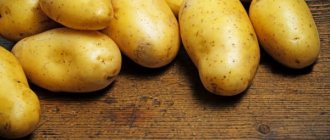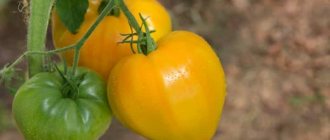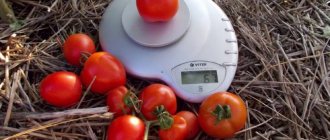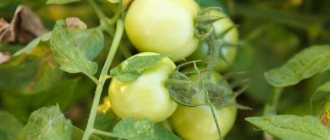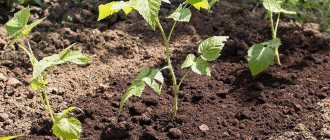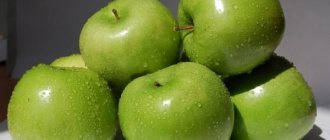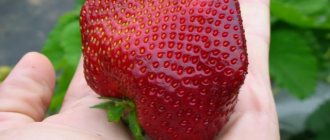White Lily
A very productive mid-season variety. Fruit ripening occurs 110-115 days after sowing. The bushes are branched, tall and strong. Each bush, 60-70 cm high, bears 6-8 fruits weighing up to 300 grams each.
White Lily eggplant is especially popular among gardeners for its outstanding flavor, reminiscent of champignon mushrooms. The peel is perfectly white, the pulp is of uniform consistency. The variety grows well both in a greenhouse and in open soil. The fruits tolerate transportation and storage well without loss of quality.
What are the benefits of white eggplants?
In pursuit of novelty and the creation of the “ideal” vegetable, breeders developed eggplants with white skin. Its pulp is tender, juicy, elastic and practically without seeds. The main difference from its purple counterparts is the lack of bitterness in the skin . There are a couple of dozen varieties and hybrids in the assortment of “white ones”; they are similar in taste, but differ in shape, ripening period and size.
Features of white eggplants:
- They don't need to be soaked.
- They do not accumulate harmful substances.
- Tastes better.
- Rich mineral and vitamin composition.
- Low calorie content.
- Does not contain solanine (a toxic substance).
Despite the hefty list of positive qualities, the vegetable should not be overused, especially by people with iron deficiency anemia and kidney disease, because eggplants remove iron from the body and contain oxalic acid.
White egg
An early variety of vegetables will delight the gardener on the 65th day after planting the seedlings. Medium-height bushes with fluffy stems reach a height of 70 cm. Can be grown in open ground.
The fruits of the variety, justifying the name, are surprising in their ovoid shape - 10 cm long and 8 cm in circumference. A distinctive quality is the large amount of ovary on the bushes. Therefore, the harvest period is longer than that of other varieties. Ripe eggplants of medium density with a mushroom flavor are perfectly stored and can withstand transportation.
Bibo F1
A variety with early fruit ripening – 80-90 days. When planting in open ground, at first it is necessary to cover the seedlings with film. The plant is spreading, heavy, and needs staking. From one bush you can get up to 4 kg of juicy, delicate-tasting vegetables. The fruits are up to 18 cm long and 8 cm in circumference, oval-conical, white outside and inside. Tasty pulp without bitterness.
The variety is thermophilic and stops developing at temperatures below 15 degrees. When cultivated in greenhouses without seedlings, the yield increases. Requires space, per 1 sq. no more than 6 bushes are planted per meter. The fruits ripen at different times.
Recent Entries
5 working ways to use tar in the garden 7 indoor plants that help you get married even in adulthood Indoor plants that can bloom in trouble
Early varieties
Early ripening varieties of eggplant include those that are ready for consumption within 70-100 days after the appearance of the first shoots.
Czech early
A variety valued by many gardeners due to the compactness of the bushes, reaching a height of no more than 60 cm. The fruits are predominantly ovoid in shape and quite large in size. The weight of one eggplant can reach 600 g. The color of the flesh is greenish-white. There is no bitter aftertaste and an excellent aroma. The pulp is dense, due to which the vegetable is used for preparing second courses and canning. The peel is dark purple.
Seeds under film are sown in mid-March in order to plant seedlings from May 25 to June 10. Planting of seedlings takes place on May 15-20. The harvest is harvested in August-September. From 1 sq. m, 4-5 kg of fruits are collected.
Vakula
The height of the bush can reach 1.2 m. The bush is spreading, which is why it needs to be tied up. The fruits have an elliptical shape. The weight of one fruit varies from 100 to 500 g. The surface of the peel is dark purple and shiny. The pulp is white, the taste is good.
Vakula eggplants are easy to care for. They require regular watering and fertilizing. They also carry out tying and other procedures. Sowing is done at the end of spring. The harvest is harvested 95-100 days after the appearance of the first shoots. From 1 sq. m harvest from 7 to 12 kg of crop.
Joker
The fruits have an elongated shape. The brushes are formed simultaneously with the fruits - 3-6 pieces. The weight of one eggplant does not exceed 140 g. The flesh is white and does not taste bitter. Seedlings are planted at the age of 60-70 days in good weather. Planting begins in early summer; accordingly, the seeds are sown in mid-March.
For planting, select areas with light, loose, well-drained sandy and sandy loam soil. It is necessary to regularly water the plant, pinch it, and fertilize it. Harvesting occurs as the fruits ripen, when they become deep purple and reach the desired length. This usually occurs 85-100 days after disembarkation. 6.8-7.2 kg of fruits are collected from 1 square meter.
Negus
A low-growing variety, reaching a height of no more than half a meter. No need for a garter. The harvest is harvested within 80 days after planting. The fruits are barrel-shaped, the weight of one vegetable is 150-300 g. With proper care of the plants, it will be possible to collect fruits throughout the season.
The color of the peel is deep purple. The flesh is light white, dense, but has a delicate, pleasant taste. Eggplants are grown through seedlings. Seeds are sown from late February to mid-March. About 7-8 kg of eggplants are harvested per square meter. They tolerate transportation well and can be stored for a long time.
Japanese dwarf
A variety that attracts with its compactness. The height of the bush does not exceed 40 cm. Eggplants are pear-shaped and weigh about 500 g. Increasing the mass is possible by covering the bushes at night. The fruit has a purple skin. The white pulp has no bitterness.
It is recommended to plant eggplants in a well-lit area; the variety does not tolerate shading well. It is necessary to choose an area with fertile, loose soil. It is important to water the plants regularly and do not forget to fertilize. The harvest is harvested 75 days after planting. Store in a dark, cool place: basement or cellar.
Faith
Eggplant Vera is an early ripening variety, suitable for those who do not want to wait a long time for the fruits to ripen. The bushes are compact in size, reaching a height of no more than 75 cm. The fruits are pear-shaped with thin, purple skin and white, dense pulp. The weight of one fruit can reach 200 g. Sowing of seeds begins in February, but it is recommended to plant in May. At this time, the first spring frosts disappear.
Eggplants are grown by seed or seedlings. Seeds are sown in the soil only in regions with a warm climate. Growing Vera eggplants is not difficult. But the crop needs watering, regular feeding, and sometimes tying up. The harvest is harvested 95-110 days after planting. About 7-10 kg of eggplants are harvested from one bush. The variety is resistant to harmful insects.
Dwarf early
An early ripening variety, ripening 80-85 days after planting. The plant is branching, but low-growing, reaching a height of no more than 50 cm. The fruits are oval, sometimes rounded-pear-shaped. The peel is dark purple. Weight – up to 150 g. The pulp is white, tender, dense. The taste is excellent.
It is necessary to carefully care for the plants: fertilize, water, and remove weeds. When harvesting from one bush, you will be able to get 6-7 kg of fruit.
Mishutka
Early ripening high-yielding variety. The fruits can be collected within 130-145 days after the appearance of the first shoots. The shape of the vegetable is elongated, pear-shaped. The skin is dark purple, almost black. The weight of one fruit can reach 900 g. Seeds begin to be sown for seedlings in late February and early March. Seedlings are planted in open ground at the beginning of June, in a greenhouse at the end of May.
The variety is unpretentious in care. It is imperative to water the plants abundantly and in a timely manner, trim leaves and small fruits, loosen the soil and feed the bushes with fertilizers. After harvesting, the fruits are stored in well-ventilated areas.
Hybrids
Modern eggplant hybrids have good taste and fertility. From one bush during the season it will be possible to collect a sufficient amount of ripe fruits, ready for consumption, transportation and storage.
Mileda F1
This hybrid is characterized by a long period of fruiting, until frost. Has excellent taste. The height of the bush is up to 1 m. The skin has a dark purple color, the length of the fruit reaches 25 cm, weight – 200-250 g. The pulp is white, creamy, juicy and tender.
Seedlings are planted in open soil along with a clod of earth. This promotes better plant survival. Seedlings need to be planted after they have 5 true leaves. Caring for plants requires necessarily loosening the soil, fertilizing, hilling and watering. The harvest is harvested 80 days after planting.
Anet F1
The hybrid is characterized by a strong bush of medium size. Eggplant ripens in 60-70 days from the day the seedlings are planted in the ground. The variety ripens early. The advantages include high yield, beautiful glossy cylindrical fruits. The skin has a dark purple color. The pulp is light, almost white, with a delicate taste. The weight of eggplant reaches 200, sometimes 400 g.
Seeds for seedlings are sown in the second half of February or the first half of March. Plants are planted in a greenhouse or in soil under film in the second half of May. The variety bears fruit until frost.
Fabina F1
The fruits have an elongated cylindrical shape. The skin is dark purple. Closer to the ripening period, the vegetable acquires a characteristic glossy shine. The fruits are equal in size, reach a length of 22 cm, and a diameter of about 6 cm. The pulp is greenish in color and has no bitterness. The bushes are compact - no more than 55 cm.
The fruits will appear within 70 days after planting the seedlings in the ground. Caring for plants involves loosening the soil, watering the plants, applying fertilizing (at least 3 per season), weeding, and hilling. Harvest time occurs about a month after the plants finish flowering.
Bourgeois F1
This is an early ripening hybrid, the fruits of which are harvested 100-110 days after emergence. The height of the bushes reaches up to one and a half meters. There is no need to install supports or tie them down. The fruits are large, round in shape, up to 13 cm in diameter. The weight of one fruit is up to 350 g. The peel is dark purple with a glossy hue. The pulp is white with a greenish tint, dense, and has no bitterness.
It is allowed to plant eggplant in open and closed ground. It grows well in any cultivation. The fruits do not ripen all at once, but gradually over 1-1.5 months. From 1 sq. m harvest up to 4.7 kg of crop. For better ripening, plants are watered twice a week and excess ovaries are removed.
Marzipan F1
Mid-season hybrid eggplant. Ripens 130 days after planting in the ground. The culture prefers warmth, so it is recommended to plant it in a greenhouse. It grows well in open ground in the southern regions of Russia. The height of the bush is up to 1 m. The fruits are large and fleshy. The length of one eggplant is up to 15 cm, width – 8 cm. The peel is dark purple, the flesh is pale cream. The weight of one fruit is about 600 g. It has a good taste.
The stem is stable, but due to its heavy weight the plant needs to be tied up. It is recommended to sow seeds in the second half of March, having previously prepared them before sowing. Caring for plants includes watering, fertilizing, and garter.
King of the North F1
Hybrid King of the North is a good option for areas with cold climates. The harvest appears 90 days after planting in the ground. The fruits are large, weighing up to 200 g. Eggplants are elongated, almost cylindrical, slightly curved. The length reaches 30 cm. The peel is dark purple, almost black, glossy. The pulp is white, without bitterness.
Seedlings are ready for planting in the ground at the age of 60-70 days. The beds are formed in advance, after filling the soil with humus or ash, and adding mineral fertilizers. Caring for plants involves watering, loosening, and forming bushes.
In this video, the blogger will show and talk about the King of the North F1 eggplant variety:
Behemoth F1
Mid-season hybrid of eggplants, characterized by high yield. The bushes are quite tall - 75-145 cm. The fruits ripen 100-112 days after the first shoots appear. The shape of the fruit is pear-shaped, the skin color is deep purple with a shiny surface. The length of the fruit reaches 14-18 cm, weight - 250-350 g. The pulp is yellowish-white, dense, almost not bitter.
Due to the fact that Behemoth is a mid-season hybrid, the seeds are sown at the end of February. It is believed that eggplants do not need to be tied up, because the stems are quite powerful. But when the fruits ripen, tall plants can simply break, so it is better to tie the stems to high stakes. The yield per 1 sq. m is 2.5-6 kg.
Clorinda F1
A very early ripening variety, ripening within 67 days after planting. It is characterized by increased resistance to adverse weather conditions and prolonged fruiting. The height of the bush reaches up to one meter. The fruits are oval in shape, their length is 22 cm, diameter is 11 cm. The weight of one vegetable is 350 g. The skin is a rich purple-black color, the flesh is white, dense, without bitterness and with a minimum number of seeds.
Planting work begins at the end of February or March. Eggplants need regular care, including watering and fertilizing. Plants respond well to the addition of mineral and organic substances. Ripeness is indicated by firm flesh and dark skin. From 1 sq. m harvest up to 5.8-6 kg of crop.
Baby White
The variety is admired for its fertility, but it is preferable to grow it in small containers. The height of the bush reaches 55 cm, the stems are pleasingly lacking thorns. Purple flowers add decorative value to vegetable bushes. The fruits are oval-shaped, creamy-white in color. The soft-tasting pulp is snow-white in color and has a delicate aroma.
It is recommended to soak the seeds in a growth stimulator for several hours before planting. After which they are dried and sown in a moist peat substrate to a depth of 1-1.5 cm. The seedlings are planted in separate containers. The plant is moisture-loving and requires regular, abundant root watering.
Icicle
The variety is characterized by yield stability when grown at different temperatures. Wide bushes up to 75 cm high bear snow-white fruits weighing up to 200 grams. The eggplant pulp is dense, juicy, without bitterness. The period of full ripening of fruits is from 110 to 120 days.
The variety is not afraid of low temperatures, so in the spring it is grown in greenhouses without heating and in the summer in open ground. Young fresh fruits do not need to be peeled before consumption.
Lilac eggplants
In addition to purple and white eggplants, breeders have obtained many intermediate forms with striped, pink-white or lilac colored fruits. Fruits should be expected from eggplant of the Lilac variety after 98–106 days. The plant forms a compact bush no more than 60 cm high, the fruits have an elongated cylindrical shape, a lilac surface and a weight of 150 to 250 grams. When cut, the fruit is white and dense. The good-tasting pulp can be used for all types of dishes and canning.
Fans of friendly, abundant harvests will appreciate the Balagur variety, which produces up to 7 fruits on the clusters. And the value of the variety lies not only in this, but also in the early ripening, excellent commercial quality of 150-gram elliptical eggplants and their excellent taste.
The mid-early eggplant variety includes the Pink Flamingo variety, which grows up to 180 cm in height in heated greenhouses. Fruits, as in the previous case, are formed on clusters of 3–6 pieces. The weight of one eggplant is 250–450 grams. What especially attracts attention to this variety is the pink-purple color of eggplants, as in the photo, as well as the white, bitter-free flesh.
Round eggplants, as a rule, are distinguished by their large size and impressive weight of fruit. The Bumbo variety is no exception. Its spherical fruits have an interesting white-lilac hue and weigh up to 700 grams. The best results are obtained by growing in a greenhouse, where the plant forms powerful bushes, showing consistently high yields.
From a number of lilac, pink and purple counterparts, the Matrosik eggplant variety shown in the photo stands out for its spectacular striped color of oval or pear-shaped fruits, weighing 100–150 grams each.
Swan
Swan is a temperature-tolerant variety that grows well in open ground. The fruits, which ripen 100-130 days after planting the seeds in the soil, are dense, with thin skin, and shaped like a curved pear or swan, hence the name. It develops well in open ground, as it is not afraid of low temperatures.
Long, cylindrical fruits of yellow-white color reach a weight of 300 grams. The pulp is snow-white, delicate in taste. The variety is characterized by high yield and long shelf life.
- Author: iarriba
Rate this article:
- 5
- 4
- 3
- 2
- 1
(1 vote, average: 5 out of 5)
Share with your friends!
What are the features of this type
White eggplant is a hybrid that evolved from a blue ancestor. The fact is that eggplants contain a substance that gives them a specific color. It's called anthocyanin. White varieties are free of it, which allows them to acquire a white, milky or yellow tint.
By the way, it is worth noting that anthocyanin itself is extremely useful. It helps get rid of free radicals, that is, it supports the body's immunity and resistance to disease.
Thus, this type of eggplant has both pros and cons. The advantages include the original appearance and the absence of taste and bitterness, to which purple eggplants are susceptible. The downside is the reduction in the beneficial properties of the product.
The white variety of this plant is not the only one. There are also, for example, Thai or fingerling options. However, in our country, the usual purple eggplants or white hybrids are popular.
